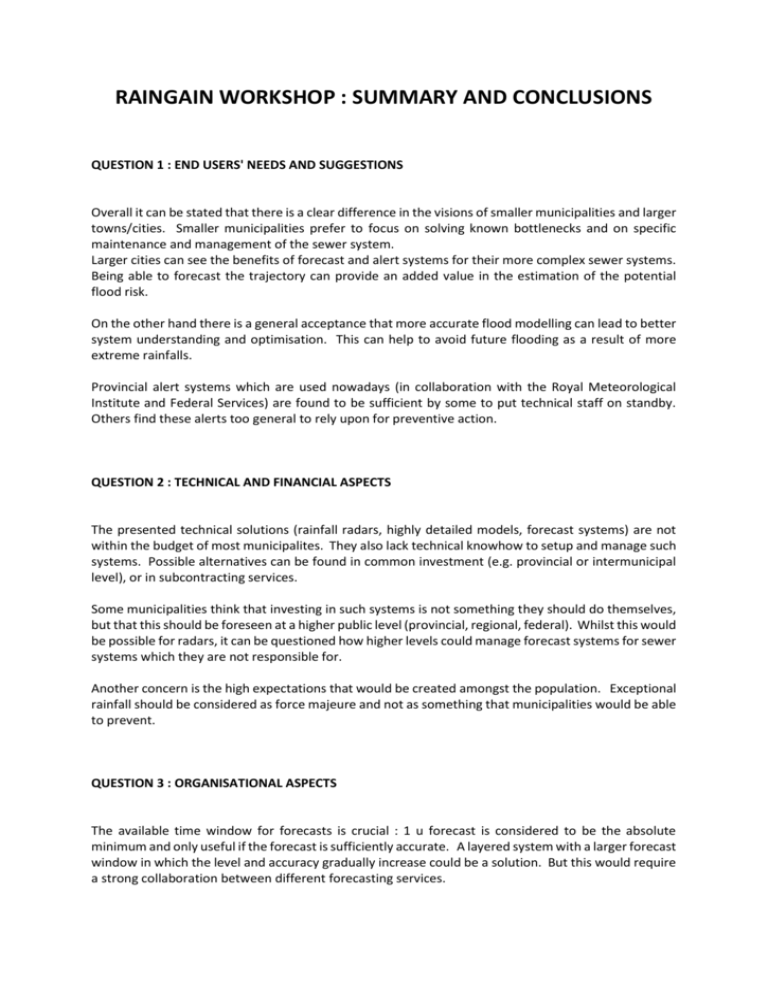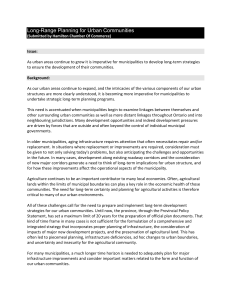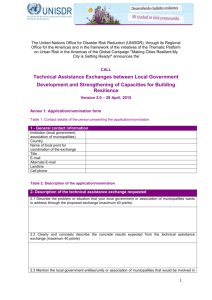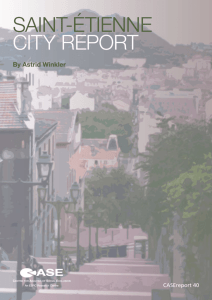Summary and Conclusions
advertisement

RAINGAIN WORKSHOP : SUMMARY AND CONCLUSIONS QUESTION 1 : END USERS' NEEDS AND SUGGESTIONS Overall it can be stated that there is a clear difference in the visions of smaller municipalities and larger towns/cities. Smaller municipalities prefer to focus on solving known bottlenecks and on specific maintenance and management of the sewer system. Larger cities can see the benefits of forecast and alert systems for their more complex sewer systems. Being able to forecast the trajectory can provide an added value in the estimation of the potential flood risk. On the other hand there is a general acceptance that more accurate flood modelling can lead to better system understanding and optimisation. This can help to avoid future flooding as a result of more extreme rainfalls. Provincial alert systems which are used nowadays (in collaboration with the Royal Meteorological Institute and Federal Services) are found to be sufficient by some to put technical staff on standby. Others find these alerts too general to rely upon for preventive action. QUESTION 2 : TECHNICAL AND FINANCIAL ASPECTS The presented technical solutions (rainfall radars, highly detailed models, forecast systems) are not within the budget of most municipalites. They also lack technical knowhow to setup and manage such systems. Possible alternatives can be found in common investment (e.g. provincial or intermunicipal level), or in subcontracting services. Some municipalities think that investing in such systems is not something they should do themselves, but that this should be foreseen at a higher public level (provincial, regional, federal). Whilst this would be possible for radars, it can be questioned how higher levels could manage forecast systems for sewer systems which they are not responsible for. Another concern is the high expectations that would be created amongst the population. Exceptional rainfall should be considered as force majeure and not as something that municipalities would be able to prevent. QUESTION 3 : ORGANISATIONAL ASPECTS The available time window for forecasts is crucial : 1 u forecast is considered to be the absolute minimum and only useful if the forecast is sufficiently accurate. A layered system with a larger forecast window in which the level and accuracy gradually increase could be a solution. But this would require a strong collaboration between different forecasting services. Smaller municipalities often share emergency services with their neighbouring municipalities, which makes it less realistic to act preventively (especially if the accuracy of the forecast can not be guaranteed). GENERAL CONCLUSION A fully elaborated system of urban flood prediction based on high resolution rainfall radars is not yet a priority for the majority of the municipalities. Larger cities however do show more interest. Technical developments in this area will continue to be investigated, but the timing for operational implementation will be determined by concrete questions from municipalities and cities. In future development of such systems the collaboration with other services (river managers, meteorological serevices) will be an important factor.








